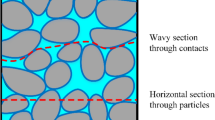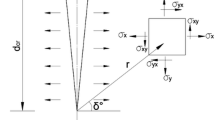Abstract
A continuum mechanics approach is used for the formulation of unsaturated hydraulic conductivity functions and the water storage functions for fractured or cracked clay soils in this parametric study. Suggested procedures are based on available research literature related to the behavior of cracked unsaturated porous media. The soil–water characteristic curve, hydraulic conductivity and water storage functions take on the character of bi-modal unsaturated soil property functions. The bimodal character arises out of the independent behavior of the cracks and the intact clay soil. Matric suction changes beneath a slab-on-grade foundation placed on a cracked clay soil profile are modeled for varied surface flux conditions using the proposed unsaturated hydraulic conductivity and water storage functions. The impact of various levels of surface cracking on soil suction distributions is discussed. Suction distribution patterns are dependent on the initial soil surface suction. In particular, the results are dependent upon whether the initial matric suction is less than or greater than the air entry of the cracked clay. There is an extremely wide range of possible conditions that could be modeled but the parametric study results presented in this paper are limited to a series of selected crack widths and densities for an exfiltration case and an infiltration case.
































Similar content being viewed by others
References
Assouline S (2001) A model for soil relative hydraulic conductivity based on the water retention characteristic curve. Water Resour Res 37:265–271
Barenblatt GI, Zheltov IP, Kochina IN (1960) Basic concepts in the theory of seepage of homogeneous liquids in fissured rocks. J Appl Math 24:1286–1303
Berkowitz B (2002) Characterizing flow and transport in fractured geological media: a review. Adv Water Resour 25:861–884
Brooks RH, Corey AT (1964) Hydraulic properties of porous media. Colorado State University Hydrology Paper, Fort Collins, Nr. 3, vol. 27, March
Burdine NT (1953) Relative permeability calculation size distribution data. Transactions of the American Institute of Mining. Metallur Petrol Eng 198:71–78
Burger CA, Shackelford CD (2001) Soil-water characteristic curves and dual porosity of sand-diatomaceous earth mixtures. J Geotech Geoenviron Eng ASCE 127(9):790–800
Campbell JD (1973) Pore pressures and volume changes in unsaturated soils. Ph.D. thesis, University of Illinois at Urbana, Champaign, Urbana-Champaign, IL, USA
Carman PC (1939) Permeability of saturated sands, soils and clays. J Agric Sci 29:262–273
Chertkov VY, Ravina I (2000) Shrinking-swelling phenomenon of clay soils attributed to capillary-crack network. Theor Appl Fract Mech 34:61–71
Durner W (1994) Hydraulic conductivity estimation for soil with heterogeneous pore structure. Water Resour Res 30(2):211–223
Fredlund MD (1996) SoilVision users guide, Version 2.0, Edition 1.0. SoilVision Systems Ltd, Saskatoon
Fredlund DG, Rahardjo H (1993) Soil mechanics for unsaturated soils. Wiley, New York
Fredlund DG, Xing A (1994) Equations for the soil-water characteristic curve. Can Geotech J 31:521–532
Gardner WR (1958) Some steady-state solutions of unsaturated moisture flow equations with application to evaporation from a water table. Soil Sci 85:228–232
Gitirana G Jr, Fredlund DG (2004) Equations for the soil-water characteristic curve based on meaningful and mathematically independent parameters, technical note. ASCE J Geotech Environ Eng 130(2):209–212
Irmay S (1954) On the hydraulic conductivity of unsaturated soils. Transactions of the American Geophysical Union, vol 35
Irmay S (1971) A model of flow of liquid-gas mixtures in porous media and hysteresis of capillary potential. Israel Institute of Technology, Haifa
Kazemi H (1969) Pressure transient analysis of naturally fractured reservoirs with uniform fracture distribution. Soc Petrol Eng J 451–62. Trans AIME 246
Kazemi H (1979) Numerical simulation of water imbibition in fractured cores. Soc Petrol Eng J 323–330
Keller CK, van der Kamp G, Cherry JA (1985) Fracture permeability and groundwater flow in clayey till near Saskatoon, Saskatchewan. Can Geotech J 23:229–240
Köhne JM, Köhne S, Gerke HH (2002) Estimating the hydraulic functions of dual-permeability models from bulk soil data. Water Resour Res 38(7):1121–1132
Kozeny J (1927) Ueber Kapillare Leitung des Wassers im Boden. Wien AkadWiss 136(2a):271
Kunze RJ, Uehara G, Graham K (1968) Factors important in the calculation of hydraulic conductivity. Soil Sci Soc Am Proc 32:760–765
Leong EC, Rahardjo H (1997) Review of soil-water characteristic curve equations. J Geotech Eng Div ASCE 123(12):1106–1117
Liu HH, Bodvarsson GS (2001) Constitutive relations for unsaturated flow in a fracture network. J Hydrol 252:16–25
Liu HH, Bodvarsson GS, Finsterle S (2004) A note on unsaturated flow in two-dimensional fracture networks. Technical note. Earth Sciences Division. Lawrence Berkeley National Laboratory. University of California, Berkeley California
Mallant D, Tseng PH, Torde N, Timmerman A, Feyen J (1997) Evaluation of multimodal hydraulic function in charactering a heterogeneous field soil. J Hydrol 195:172–199
Mualem Y (1976) A new model for predicting the hydraulic conductivity of unsaturated porous media. Water Resour Res 12:593–622
Novák V, Simunek J, van Genuchten MTh (2000) Infiltration into soil with fractures. J Irrig Drain Eng 126(1):41–47
Odeh AS (1965) Unsteady-state behavior of naturally fractured reservoirs. J Soc Petrol Eng 3:60–64
Peters RR, Klavetter EA (1988) A continuum model for water movement in unsaturated fractured rock mass. Water Resour Res 24(3):416–430
Pruess K, Narasimhan TN (1985) A practical method for modeling fluid and heat flow in fractured porous media. Soc Petrol Eng J 25:14–26
Sillers WS, Fredlund DG, Zakerzadeh N (2002) Mathematical attributes of some soil-water characteristics curve models. Geotech Geol Eng J 19:243–283
Snow DT (1965) A parallel plate model of fractured permeable media, Ph.D. dissertation, University of California, Berkeley, 331 p
Stothoff S, Or D (2000) A discrete-fracture boundary integral approach to simulating coupled energy and moisture transport in a fractured porous medium. In: Faybishenko B, Witherspoon PA, Benson SM (eds) Dynamics of fluids in fractured rocks, concepts, and recet advances. AGU Geophysical Monograph 122
van Genuchten M Th (1980) A closed form equation for predicting the hydraulic conductivity of unsaturated soils. Soil Sci Soc Am J 44:892–898
Warren JE, Root PJ (1963) The behavivor of naturally fractured reservoirs. Soc Petrol Eng J 245–255. Trans AIME 228
Wu TH (1976) Soil mechanics, 2nd edn. Allyn asnd Bacon, Boston
Wu YS (2000) On the effective continuum method for modeling multiphase flow, multi-component transport and heat transfer in fractured rock. In: Faybishenko B, Witherspoon PA, Benson SM (eds) Dynamics of fluids in fractured rocks, concepts, and recent advances. AGU Geophysical Monograph 122
Wu YS, Pruess K (2005) A physically based numerical approach for modeling fracture-matrix interaction in fractured reservoirs. In; Proceedings world geothermal congress 2005, Antalya, Turkey, 24–29 April 2005, pp 1–8
Wu YS, Haukwa C, Bodvarsson GS (1999) A site-scale mmodel for fluid and heat flow in the unsaturated zone of Yucca Mountain, Nevada. J Contam Hydrol 38(1–3):185–217
Zhang L, Fredlund DG (2004) Characteristics of water characteristic curves for unsaturated fractured rocks. In: The second Asian conference on unsaturated soils, Unsat-Asia, Osaka, Japan, pp 425–428
Acknowledgments
This work was supported by the Homebuilders’ Association of Central Arizona, and in part by NSF under grant no. CMMI-0825089. The views presented in this paper are those of the authors and not necessarily those of the Homebuilders’ Association of Central Arizona.
Author information
Authors and Affiliations
Corresponding author
Rights and permissions
About this article
Cite this article
Fredlund, D.G., Houston, S.L., Nguyen, Q. et al. Moisture Movement Through Cracked Clay Soil Profiles. Geotech Geol Eng 28, 865–888 (2010). https://doi.org/10.1007/s10706-010-9349-x
Received:
Accepted:
Published:
Issue Date:
DOI: https://doi.org/10.1007/s10706-010-9349-x




